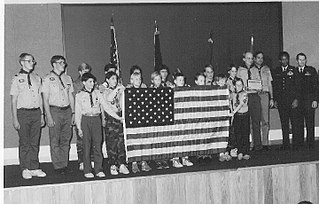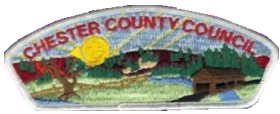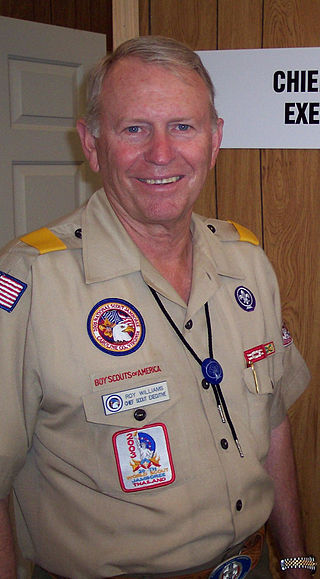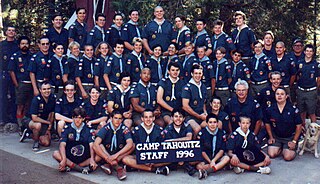
The Order of the Arrow (OA), previously known as Wimachtendienk Wingolauchsik Witahemui (WWW) is the honor society of the Boy Scouts of America (BSA), composed of Scouts and Scouters who best exemplify the Scout Oath and Law in their daily lives as elected by their peers. Started as a Camp Fraternity by E. Urner Goodman, with the assistance of Carroll A. Edson, in 1915, its goal was to reinforce the Scout Oath and the Scout Law. Started without approval of Boy Scouts of America (BSA), it became an "Official Experiment" of the scouting organization. In 1948, following an extensive review, it officially became a program of Boy Scouts of America.

Scouting in Colorado has a long history, from the 1910s to the present day.

Scouting in Kansas has a long history, from the 1910s to the present day, serving thousands of youth in programs that suit the environment in which they live.

Scouting in Missouri has a long history, from the 1910s to the present day.

The Greater St. Louis Area Council (GSLAC) of the Boy Scouts of America was formed in 1911 and is based in St. Louis, Missouri. The council serves Scouts in the St. Louis Metro area, southeast Missouri, and southern and central Illinois.

Harold Roe Bennett Sturdyvant Bartle, better known as H. Roe Bartle, was an American businessman, philanthropist, executive, and professional public speaker who served two terms as mayor of Kansas City, Missouri. After Bartle helped lure the Dallas Texans American Football League team to Kansas City in 1962, owner Lamar Hunt renamed the franchise the Kansas City Chiefs after Bartle's nickname, The Chief.

Edward Urner Goodman was an influential leader in the Boy Scouts of America (BSA) movement for much of the twentieth century. Goodman was the national program director from 1931 until 1951, during the organization's formative years of significant growth when the Cub Scouting and Exploring programs were established. He developed the BSA's national training center in the early 1930s and was responsible for publication of the widely read Boy Scout Handbook and other Scouting books, writing the Leaders Handbook used by Scout leaders in the United States during the 1930s and 1940s. In the 1950s, Goodman was Executive Director of Men's Work for the National Council of Churches in New York City and active in church work.

The Chester County Council is a Boy Scouts of America service council that serves members of the Cub Scouts, Scouts BSA, and Venturing programs in Chester County, Pennsylvania and Northeastern Cecil County, Maryland. It is one of the oldest councils in the nation, and is one of two single-county councils left in Pennsylvania, the other being Chief Cornplanter Council in Warren, PA.

The Chief Scout Executive is the top professional of the National Council of the Boy Scouts of America. In most similar non-profit organizations, this is equivalent to the position of CEO, national executive director or secretary general.

Roy Williams is the former Chief Scout Executive of the Boy Scouts of America. He is the tenth person to hold that position, serving between 2000–2007.

The Tahquitz Community is one of a few local Boy Scout honor societies in the United States that have not been absorbed by the Order of the Arrow. The organization was created in 1925 and consisted of 15 honor Scouts who were chosen to start and maintain a perpetual volunteer summer camp staff at Camp Tahquitz.
Jere Brian Ratcliffe was a professional Scouter in the Boy Scouts of America who was the ninth Chief Scout Executive.

Heart of America Council serves Scouts in Missouri and Kansas. This council was formed on July 1, 1974, with the merger of the former Kansas City Area and Kaw Councils.
Unami Lodge, One is the Order of the Arrow (OA) lodge of the Cradle of Liberty Council, Boy Scouts of America (BSA) and the founding Lodge of the OA, having celebrated its centennial in 2015. The current Unami Lodge resulted from the 1996 merger of Unami Lodge 1 and Delmont Lodge 43, caused by the merger of Philadelphia Council and Valley Forge Council. The chiefs of each lodge agreed to preserve Unami's rich history and traditions by retaining the founding lodge's name and number. Delmont Lodge's history, including its roster of Vigil Honor, Founder's Award, and David Fortunato Outstanding Service Award recipients, is preserved as part of Unami Lodge's history. The lodge's totem is the turtle, reflecting both the name of the animal (unami) in the Delaware language, but also its association with its peoples.

Robert J. "Bob" Mazzuca was the 11th Chief Scout Executive of the Boy Scouts of America. His term started in 2007, and he retired on August 31, 2012.

The Lincoln Heritage Council (LHC) is a local council of the Boy Scouts of America serving 64 counties in four states: Kentucky, Indiana, Illinois, and Tennessee.
Alden G. Barber was a long-serving professional Scouter for the Boy Scouts of America, and served as the fifth Chief Scout Executive of the BSA from 1967 to 1976. He served during the peak membership years of the BSA, and was instrumental in modernizing the BSA program, particularly the Boy Scout program for boys ages 11 to 17.

The Winnebago Council is a council of the Boy Scouts of America (#173). The Winnebago Council serves Scouts BSA, Cub Scouts, adult volunteers and Venturers in 17 counties located in North Central Iowa. Including: Black Hawk, Grundy, Butler, Franklin, Wright, Hancock, Winnebago, Worth, Cerro Gordo, Mitchell, Floyd, Bremer, Chickasaw, Howard, Winneshiek, Fayette, and Buchanan.

The Coronado Area Council is the local council of the Boy Scouts of America (BSA) that serves Scouts in north central and northwest Kansas, across 32 counties, with headquarters in Salina.
The Kansas City Chiefs is one of the professional sports teams involved in the controversy regarding the use of Native American names and imagery, but received less attention than other teams until 2013 when fan behavior at games, including stereotypical headdresses, face paint, performing a "war chant" and tomahawk chop became more publicly known. Protests by change advocates intensified following the name changes of the Washington Commanders and Cleveland Guardians. In addition, the Chiefs have been highly visible due to their participation in the Super Bowl in the 2019, 2020, 2022, and 2023 seasons and widespread media coverage. Native American groups demonstrated outside the stadium hosting Super Bowl LVII.




















